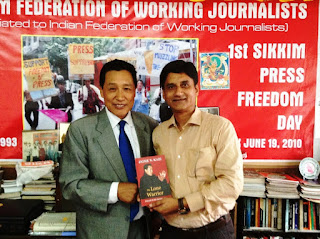The Lone Warrior: Exiled In
My Homeland
By JIGME N. KAZI
Publisher:
Hill Media Publications
Price:
Rs. 525/-
Sequel to his previous book, Inside
Sikkim: Against the Tide (published in 1993), Jigme N. Kazi’s new book, The Lone Warrior: Exiled In My Homeland,
highlights the downfall of the Nar Bahadur Bhandari regime, which ruled Sikkim
for a decade and half (1979-1994), and subsequent events in the former kingdom
leading to formation of Pawan Chamling-led Sikkim Democratic Front (SDF)
government in December 1994.
The book, released in 2014, delves deeply into social, religious and
political issues – Assembly seat reservation, income tax, Rathongchu hydro
power project, scaling of Khangchendzonga, Gurudongmar lake controversy,
Opposition unity – that the Chamling Government confronted during its first
three successive terms in office (1994-2009).
The Lone Warrior: Exiled In My Homeland also seeks to highlight how and why the author – a journalist –
left the safe confines of his profession and joined active politics. Was he
after ‘power politics’ or did he truly struggle for ‘people power’ to triumph
in Sikkim?
In
his recent book, Sikkim For Sikkimese,
the author reveals his professional and political struggle of two and half
decades (1983-2008) to safeguard Sikkim’s ‘distinct identity within the Union.’
In The Lone Warrior: Exiled In My Homeland Jigme N. Kazi
shows that he can use the pen and the sword with equal flare and ferocity. His
personal confrontation with those within and outside his political circle on
diverse issues makes it a must-read book for those who are looking for unique
insights into how the political elite of established political parties play the
game of survival.
More than anything The Lone Warrior: Exiled In My Homeland reveals how one can fight
head-on and take on the powers-that-be for the common cause and come out
unscathed and with one’s credibility intact.
Published by Hill Media Publications, Gangtok, the 276-page book priced
at Rs 525/- is available at Observer Building, Nam Nang, Gangtok, Sikkim and at
the local books shops in Gangtok and Darjeeling.
AVAILABLE
AT:
Observer Building, Nam Nang, Gangtok,
Sikkim
Kandoika, New Market, MG Marg, Gangtok,
Sikkim
Good Books: Old Market, MG Marg, Gangtok,
Sikkim
Jainco: New Metro Point, 31A National
Highway, Gangtok, Sikkim
Rachna: Development Area, Gangtok, Sikkim
Oxford Books: Chowrasta, Darjeeling
Bulk
copies available at Observer Building, Nam Nang, Gangtok, Sikkim.












.jpg)
.jpg)


.jpg)
.jpg)
.jpg)
.JPG)

